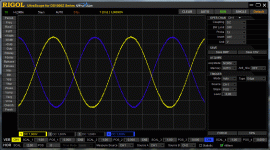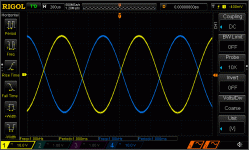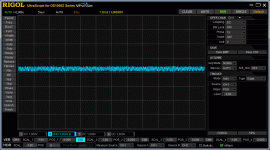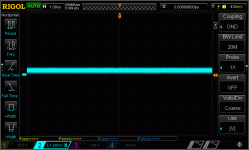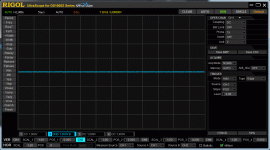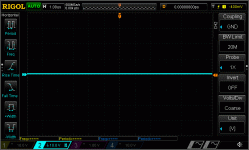Hi jitter,
Your Rigol works better than many, ignoring the money. You will love this little guy.
You should see if Keysight software works with this scope. LXI ready? How was the LAN setup? This is one area where all scopes have done well.
Hi timpert,
-Chris
Your Rigol works better than many, ignoring the money. You will love this little guy.
You should see if Keysight software works with this scope. LXI ready? How was the LAN setup? This is one area where all scopes have done well.
Hi timpert,
Don't want one. Go get one!Now you really made me want one!
-Chris
A couple of weeks ago my Tek 7613 frame packed in. That frame is almost as old as I am.
I picked up Tek 2465 300MHz on ebay. Probably paid way to much for it.
Chris do find a lot of HF noise in the trace in full bandwidth?
It looks good with the BW reduced to 20MHz. Maybe it's just the cost of admission for a wide BW amplifier.
One of the knob caps is missing on the intensity pot. Would you have any spare knobs for this model?
I picked up Tek 2465 300MHz on ebay. Probably paid way to much for it.
Chris do find a lot of HF noise in the trace in full bandwidth?
It looks good with the BW reduced to 20MHz. Maybe it's just the cost of admission for a wide BW amplifier.
One of the knob caps is missing on the intensity pot. Would you have any spare knobs for this model?
Hi David,
The only knobs I have are on my 2465! There is an outfit near you that sells knobs and such. At least those are available, the ones for my 2235 are NLA or too expensive. Not much of a choice there.
My 2465 (it's a "B" model) settled down nicely. It was noisy, took it apart to have a look. Couldn't find anything obvious so it went back together. Nice sharp trace now. I did make threatening noises, maybe that was it. Could be that shipping jarred something and I fixed it just messing around. Loose plug or something. I tend to check all screws and plugs when I have a problem with something.
Could be that shipping jarred something and I fixed it just messing around. Loose plug or something. I tend to check all screws and plugs when I have a problem with something.
Your 2465 shouldn't have a noisy trace. Mine is just about the same in wideband as in the BW restrict mode. If you have some 50R loading BNC caps, stick them on and try it again. If you do see noise still, I would begin with checking bypass caps. Maybe the seller "fixed" a dead scope problem by snipping a shorted tantalum lead. Nothing would surprise me these days. Have you checked the attenuator switches by chance?
You should have been looking at Crown Assets for equipment. Ebay is such a scary place for "good" gear. You almost have to buy from a calibration lab to ensure the damn thing works from Ebay. The only one thing I bought from Ebay that wasn't problematic was a 3457A meter. The first one arrived with no calibration constants, but the vendor took it back and sent me another. I hope he changed the battery (3V lithium). I ordered a pair of those before I take that meter apart to check. They should arrive next week.
I can't remember what my scope cost, but it wasn't cheap. I lost a few bids, so I bid on this with a slightly higher price than the winning bids were. These do tend to be expensive scopes, so you may have paid fair market value.
Your 7613 is a really nice scope. Can't you repair it? It may be old, but that doesn't mean it won't run circles around other scopes. I repaired a old HP 1722A (275 MHz dual trace with a digital readout) and it performs really well! This thing was built in 1974 when I was in high school. I'm going to use this one from time to time, just because it is so cool. It would be sad if you can't fix that 7613. You obviously have all the plug-in modules for it. Don't they make a spectrum analyzer plug-in for it? Then there is the differential amp, the curve tracer, power supply and generator that all fit in, or am I thinking of something else?
-Chris
The only knobs I have are on my 2465! There is an outfit near you that sells knobs and such. At least those are available, the ones for my 2235 are NLA or too expensive. Not much of a choice there.
My 2465 (it's a "B" model) settled down nicely. It was noisy, took it apart to have a look. Couldn't find anything obvious so it went back together. Nice sharp trace now. I did make threatening noises, maybe that was it.
Your 2465 shouldn't have a noisy trace. Mine is just about the same in wideband as in the BW restrict mode. If you have some 50R loading BNC caps, stick them on and try it again. If you do see noise still, I would begin with checking bypass caps. Maybe the seller "fixed" a dead scope problem by snipping a shorted tantalum lead. Nothing would surprise me these days. Have you checked the attenuator switches by chance?
You should have been looking at Crown Assets for equipment. Ebay is such a scary place for "good" gear. You almost have to buy from a calibration lab to ensure the damn thing works from Ebay. The only one thing I bought from Ebay that wasn't problematic was a 3457A meter. The first one arrived with no calibration constants, but the vendor took it back and sent me another. I hope he changed the battery (3V lithium). I ordered a pair of those before I take that meter apart to check. They should arrive next week.
I can't remember what my scope cost, but it wasn't cheap. I lost a few bids, so I bid on this with a slightly higher price than the winning bids were. These do tend to be expensive scopes, so you may have paid fair market value.
Your 7613 is a really nice scope. Can't you repair it? It may be old, but that doesn't mean it won't run circles around other scopes. I repaired a old HP 1722A (275 MHz dual trace with a digital readout) and it performs really well! This thing was built in 1974 when I was in high school. I'm going to use this one from time to time, just because it is so cool. It would be sad if you can't fix that 7613. You obviously have all the plug-in modules for it. Don't they make a spectrum analyzer plug-in for it? Then there is the differential amp, the curve tracer, power supply and generator that all fit in, or am I thinking of something else?
-Chris
Hi David,
The only knobs I have are on my 2465! There is an outfit near you that sells knobs and such. At least those are available, the ones for my 2235 are NLA or too expensive. Not much of a choice there.
My 2465 (it's a "B" model) settled down nicely. It was noisy, took it apart to have a look. Couldn't find anything obvious so it went back together. Nice sharp trace now. I did make threatening noises, maybe that was it.Could be that shipping jarred something and I fixed it just messing around. Loose plug or something. I tend to check all screws and plugs when I have a problem with something.
Your 2465 shouldn't have a noisy trace. Mine is just about the same in wideband as in the BW restrict mode. If you have some 50R loading BNC caps, stick them on and try it again. If you do see noise still, I would begin with checking bypass caps. Maybe the seller "fixed" a dead scope problem by snipping a shorted tantalum lead. Nothing would surprise me these days. Have you checked the attenuator switches by chance?
You should have been looking at Crown Assets for equipment. Ebay is such a scary place for "good" gear. You almost have to buy from a calibration lab to ensure the damn thing works from Ebay. The only one thing I bought from Ebay that wasn't problematic was a 3457A meter. The first one arrived with no calibration constants, but the vendor took it back and sent me another. I hope he changed the battery (3V lithium). I ordered a pair of those before I take that meter apart to check. They should arrive next week.
I can't remember what my scope cost, but it wasn't cheap. I lost a few bids, so I bid on this with a slightly higher price than the winning bids were. These do tend to be expensive scopes, so you may have paid fair market value.
Your 7613 is a really nice scope. Can't you repair it? It may be old, but that doesn't mean it won't run circles around other scopes. I repaired a old HP 1722A (275 MHz dual trace with a digital readout) and it performs really well! This thing was built in 1974 when I was in high school. I'm going to use this one from time to time, just because it is so cool. It would be sad if you can't fix that 7613. You obviously have all the plug-in modules for it. Don't they make a spectrum analyzer plug-in for it? Then there is the differential amp, the curve tracer, power supply and generator that all fit in, or am I thinking of something else?
-Chris
You got it right with the plugins.
I also bid on a 7633. The big brother to the 7613. Same frame but way faster storage.
I won the bid. Got it for 10.00 US. it was sold as a parts unit but I know what the problem is. Large can cap in the PS. I had to do the same with the 7613. I had it shipped to Dick Moore who is checking it out for me. Possibly repairing it as well.
Either the CRT is gone in the 7613 or the flyback. In either case I think it is finished. End of life. But I have a whole chassis of available parts and another frame.
Hi David,
I'm sorry, it does sound terminal. No sense looking further when you have it down to to CRT or flyback. I'll bet the shipping for the new 7633 costs a lot more than the price you paid! $10, good score. You will end up with a better scope and have all the plug-ins for it. Win-win.
I have been playing with a curve tracer lately. Now I want to check out a Tektronix version that I can get numbers from. That and the others use a sine wave which leads to looping. A saw tooth is the only way to go, but I don't have time to build a curve tracer.
Please let me know how your 2465 works out. I wish you luck with it.
Best, Chris
I'm sorry, it does sound terminal. No sense looking further when you have it down to to CRT or flyback. I'll bet the shipping for the new 7633 costs a lot more than the price you paid! $10, good score. You will end up with a better scope and have all the plug-ins for it. Win-win.
I have been playing with a curve tracer lately. Now I want to check out a Tektronix version that I can get numbers from. That and the others use a sine wave which leads to looping. A saw tooth is the only way to go, but I don't have time to build a curve tracer.
Please let me know how your 2465 works out. I wish you luck with it.
Best, Chris
Howdy AR2,
Started with a 20 MHz, dual trace? Then into the Tektronix family? How was the 485 to work with? I'm curious because I have a 468 here that doesn't work and am thinking of restoring it.
Yokogawa is related to Agilent in some way I think. I am not surprised you liked that one. You don't see much of their stuff over here, unless you look at the rear panel of HP / Agilent products here and there. Generally pretty good stuff.
Your LeCroy sounds like another really good scope. They are different, but I didn't know they were that different. I have never borrowed one to work with. Anyway, that scope was pretty expensive, and I'll bet it can do some pretty whiz-bang stuff! How long have you had it now?
There are a lot of analogue scopes to choose from that are more than good enough. The Tek is okay, but so is the Gould and many others. Your LeCroy will handle the measurements, so the analogue scope is more for looking at waveform quality. A Philips has a really sharp trace. Another Yokogawa might make sense.
Now time for a chuckle. I just got an old B&K 2120 (20 MHz) scope running. It took three days and had problems in every circuit. When I started, the -2 KV tube supply measured over 4 KV! Some caps (film types) blew sections of their case off with a loud cracking. I didn't bother to attempt to read the actual voltage. It's -ve 12 V supply went positive also, just a complete mess. The trace was an entire division wide (1 cm!). Now it's happy, just waiting for a calibration. Someone messed with many trimmers, lovely. I think this one will become attached to a curve tracer. The two BNC inputs can be changed to banana jacks.
-Chris
Hi Chris,
Yes on Hitachi dual trace 20MHz. 485 was a great scope and really easy to work with. Awesome triggering. For analog, I really like Tek scopes, but not digital ones. My 485 worked great, until its screen went caput. Than I got two of Yokogawa scopes - loaner from friend - first 1520 than 1740. You are correct Yokogawa was partner with HP and they did a lot together. Great digital scopes, very intuitive and logical. Outstanding interface. Yokogawa scopes are best hidden secret. Not too many people know about them, and they are built really well - based on HP standards. I would recommend those any time.
About three months ago, I purchased LeCroy LT584 because I wanted to return those Yokogawas and wanted to buy something good for a long time to serve. I found it for a very good price, together with two 1GHz FET probes. I already had their 100MHz DA1855A differential amplifier, so all of a sudden I had very good LeCroy system. My Le Croy came with many options. Do not get me wrong it is great scope, I just need to be very concentrated to be able to use all of its features. It is something else compared to anything I had before. It has great zooming features. Its analog simulation is called Analog Persist which does sort of averaging - displays all curves over period of time, where I could go back and list and look each one separately if I want. It has extremely powerful graphing, FFT, measurements, math, zoom and triggering functions... It is sort of too much to remember all how to use (I am not usng it every day, just here and there). I have to say, Yokogawa was more logical and easier to use. I am amazed with LeCroys triggering. When it locks on a signal it is dead stable.
You got it right with the plugins.
I also bid on a 7633. The big brother to the 7613. Same frame but way faster storage.
I won the bid. Got it for 10.00 US. it was sold as a parts unit but I know what the problem is. Large can cap in the PS. I had to do the same with the 7613. I had it shipped to Dick Moore who is checking it out for me. Possibly repairing it as well.
Either the CRT is gone in the 7613 or the flyback. In either case I think it is finished. End of life. But I have a whole chassis of available parts and another frame.
David,
To me quite honest, your better bet is to bid on this scope:-
Tektronix 7104 Analog Oscilloscope with Modules | eBay
This is arguably the VERY best Analogue scope ever made - I say "Arguably", as the Tek 11032A is also a very strong contender but these are as rare as Hens teeth in good condition thesedays.
You would need to find a decent set of plugins - 7A26 is a decent "starter" 250MHz Dual channel 1M / 50 Ohm input Amp - and the 7B92A the best Timebase. (the 7B10 / 7B15 are faster with a 200pS Div setting but not as flexible).
We can discuss other plug-in options if your secure the Mainframe...
The Mainframe is rated at 1GHz, usable to 1.5GHz - 2GHz no problem.
The Scope uses an Image intensifier (MCP) on the front of the tube to observe the fast sweeps without the need of a viewing hood.
Now sold for peanuts, but makes everything else Mickey Mouse...
David,
To me quite honest, your better bet is to bid on this scope:-
Tektronix 7104 Analog Oscilloscope with Modules | eBay
This is arguably the VERY best Analogue scope ever made - I say "Arguably", as the Tek 11032A is also a very strong contender but these are as rare as Hens teeth in good condition thesedays.
You would need to find a decent set of plugins - 7A26 is a decent "starter" 250MHz Dual channel 1M / 50 Ohm input Amp - and the 7B92A the best Timebase. (the 7B10 / 7B15 are faster with a 200pS Div setting but not as flexible).
We can discuss other plug-in options if your secure the Mainframe...
The Mainframe is rated at 1GHz, usable to 1.5GHz - 2GHz no problem.
The Scope uses an Image intensifier (MCP) on the front of the tube to observe the fast sweeps without the need of a viewing hood.
Now sold for peanuts, but makes everything else Mickey Mouse...
Well I agree but I have no place to put that and the shipping would be a killer. If I could find one closer to home maybe but it a monster.
I have all the plugins from my 7613. Would just need the timebase and 1Gig amplifier.
Hi jitter,
Your Rigol works better than many, ignoring the money. You will love this little guy.
You should see if Keysight software works with this scope. LXI ready? How was the LAN setup? This is one area where all scopes have done well.
Hi timpert,
Don't want one. Go get one!
-Chris
Hi anatech,
I installed the tools for remote access to the Rigol which also included some stuff from National Instruments (NI MAX). Although it looks like something I might sometimes use at work, I'm not really familiar with it (I'm only a user, I don't install or set things up with it).
From Rigol's site I downloaded the tool to remotely access the scope (via USB or LAN) and it works, but I'm not impressed. The tool doesn't fully work (yet?). I can control many functions remotely, but strangely, not the vertical or horizontal scales. There are controls for them, but they don't respond.
Also, the update rate of the screen on the computer monitor is really poor, typically somewhere around 2 to 5 times per second.
It looks like the tool ("Ultrascope") isn't really finished yet. I'll post a screenshot later.
The Rigol scopes are USBTMC compliant, and so you should be able to control them from your own favorite programming environment, see for example Controlling a Rigol oscilloscope using Linux and Python | C i b o M a h t o . c o m
Also see http://digital.ni.com/public.nsf/allkb/044FA220F32774ED86256DB3005850CA
Neat, isn't it?
Also see http://digital.ni.com/public.nsf/allkb/044FA220F32774ED86256DB3005850CA
Neat, isn't it?
Hi AR2,
Yes, found the LeCroy the same. Very good product and a top brand, but using it takes a bit to learn. Something like getting use to my Philips PM-3070 with its switches instead of the normal rotary pots. I guess they did that to be able to remotely control the scope. I should look into that for the 488 bus.
The best thing for you to do is just play. Do you have a normal pair of scope leads? You should use those normally and save the FET probes for when you need them. It would be a shame to damage your lovely FET probes.
Your differential probes are hidden gems. I have some Tek differential probes and the external amplifier. I can use them with any scope (good thing!). All in all you have a very powerful system there -as you know. I'm glad you have that stuff.
-Chris
Yes, found the LeCroy the same. Very good product and a top brand, but using it takes a bit to learn. Something like getting use to my Philips PM-3070 with its switches instead of the normal rotary pots. I guess they did that to be able to remotely control the scope. I should look into that for the 488 bus.
The best thing for you to do is just play. Do you have a normal pair of scope leads? You should use those normally and save the FET probes for when you need them. It would be a shame to damage your lovely FET probes.
Your differential probes are hidden gems. I have some Tek differential probes and the external amplifier. I can use them with any scope (good thing!). All in all you have a very powerful system there -as you know. I'm glad you have that stuff.
-Chris
Hi jitter,
Use the LAN connection as it is isolated from everything else. USB will connect the grounds to your computer.
Try, just for giggles, try the Keysight - Agilent software for their series that looks the same as what you have. Agilent software tends to also talk to other brands. They also have a utility that looks for other instruments and lists them. This may solve your problems with connecting to your instrument.
Free downloads, no excuses not to try!
-Chris
Use the LAN connection as it is isolated from everything else. USB will connect the grounds to your computer.
Try, just for giggles, try the Keysight - Agilent software for their series that looks the same as what you have. Agilent software tends to also talk to other brands. They also have a utility that looks for other instruments and lists them. This may solve your problems with connecting to your instrument.
Free downloads, no excuses not to try!
-Chris
Hi jitter,
Use the LAN connection as it is isolated from everything else. USB will connect the grounds to your computer.
Good advice, I hadn't thought about that.
Try, just for giggles, try the Keysight - Agilent software for their series that looks the same as what you have. Agilent software tends to also talk to other brands. They also have a utility that looks for other instruments and lists them. This may solve your problems with connecting to your instrument.
Free downloads, no excuses not to try!
-Chris
The connecting part works fine, but the remote operating part can do with some improvement.
The first attachment shows what it looks like on the computer monitor. The second is what it looks like when the screen is captured by Ultrascope. This is the same as when it is saved on a thumb drive directly on the scope.
Compare the sampling rate of both captures and weep... (I'm assuming that the 5 Sa/s on the PC screen is actually the update rate, the scope is sampling at 500 MSa/s).
I'll indeed have to play around with the Keysight software and see if it works. Perhaps this weekend...
Attachments
Last edited:
Jitter,
What's the noise on the signwave? is it oscillation on the source or is it sampling effects of the scope? - apparently your at 1V per DIV so I doubt its noise?
To me it looks like a HF signal riding the Signwave - I typically see this on an Analogue scope when there is low level HF oscillation (say from an incorrectly compensated Opamp).
What's the noise on the signwave? is it oscillation on the source or is it sampling effects of the scope? - apparently your at 1V per DIV so I doubt its noise?
To me it looks like a HF signal riding the Signwave - I typically see this on an Analogue scope when there is low level HF oscillation (say from an incorrectly compensated Opamp).
Jitter,
What's the noise on the signwave? is it oscillation on the source or is it sampling effects of the scope? - apparently your at 1V per DIV so I doubt its noise?
My guess is sampling effects, but those aren't easily visible on the screen of the scope, that looks the same as the second attachment of my previous post.
To me it looks like a HF signal riding the Signwave - I typically see this on an Analogue scope when there is low level HF oscillation (say from an incorrectly compensated Opamp).
Here are some more attachments. First and second are with the input switched to GND and scale most sensitive (1 mV/div). The third and fourth the same with the scale in the least sensitive setting (10 V/div). Don't mind the settings shown in the UltraScope tool, many of them are incorrect. The screendumps from the scope (second and third) are correct and as shown on the screen of the scope.
Attachments
Last edited:
My guess is sampling effects, but those aren't easily visible on the screen of the scope, that looks the same as the second attachment of my previous post.
Here are some more attachments. First and second are with the input switched to GND and scale most sensitive (1 mV/div). The third and fourth the same with the scale in the least sensitive setting (10 V/div). Don't mind the settings shown in the UltraScope tool, many of them are incorrect. The screendumps from the scope (second and third) are correct and as shown on the screen of the scope.
Your first screen shoot is amazing as if I "read" it correcting the input to the scope is grounded and at 1V DIV. and yet there's so much noise - is that really possible?
If its the scopes Noise floor, then this will hide any HF Low level oscillation you might have riding on a waveform.
I wonder if its a Software issue?
Edit - I see you say there are at 1mV not 1V Div as indicated, then its OK! I could not believe it was that Bad!
Why the indicated scaling error?
Last edited:
Edit - I see you say there are at 1mV not 1V Div as indicated, then its OK! I could not believe it was that Bad!
Why the indicated scaling error?
Yes, the scales, coupling, etc. indicated by the remote controlling tool on the PC (UltraScope) are incorrect, that's why I also included the screendumps generated by the scope (and of course to show the difference between what UltraScope shows and what the scope itself shows).
I'm assuming that the problem lies with the UltraScope software as the scope itself seems to work fine. But I have yet to look at a forum to see if other people experience the same issues with UltraScope.
Edit: of course the following from my previous post was wrong: "The screendumps from the scope (second and third) are correct and as shown on the screen of the scope."
It should have read: "The screendumps from the scope (second and fourth) are correct and as shown on the screen of the scope."
Last edited:
- Status
- This old topic is closed. If you want to reopen this topic, contact a moderator using the "Report Post" button.
- Home
- Design & Build
- Equipment & Tools
- Oscilloscope woes
